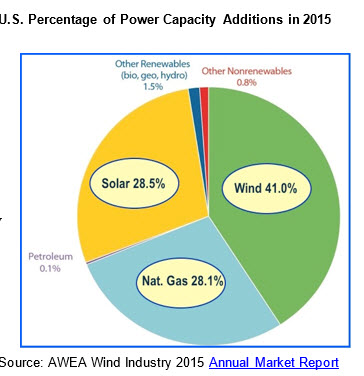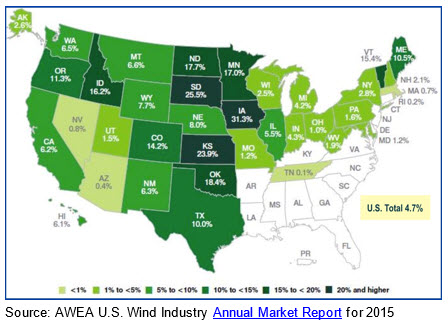WASHINGTON, April 21, 2016 - Wind energy is already cutting consumers’ electricity bills in many states across the U.S. If current policies and trends continue, the wind industry forecasts that boosting wind energy from today’s 4.7 percent to 35 percent of the U.S. electricity supply by 2050 will “save American consumers $14 billion a year, with cumulative savings on their electric bills of $149 billion.”
The American Wind Energy Association (AWEA) expanded on its positive outlook last week when it unveiled its Annual Market Report for 2015 at a Vestas factory in Colorado that makes nacelles, or housings, for wind turbines. At the event, David Eves, the president of a major power supplier in Colorado called the Public Service Co., explained why he expects wind to continue increasing its market share.
“We have cultivated wind as our most cost-effective renewable energy option because we recognize that this source of energy is not only a benefit to the environment but also a major economic driver for the state,” he said. “Our plan is to expand our wind offerings to provide hundreds of new jobs for Coloradans, make a billion dollars in new investments, keep energy costs low for our customers, and improve the environment.”
Chris Brown, president of Vestas Americas and incoming AWEA board chair, also spoke at the event, saying “Innovative turbine technology has cut the cost of wind energy by two-thirds in just six years.”
“Our job growth and cost cutting is showing state policymakers and utilities how zero-emissions wind turbines are the economical and environmental solution for cutting carbon pollution cost-effectively,” he said.
As a result of wind’s cost cutting, AWEA CEO Tom Kiernan says wind is now established as “the lowest-cost source of new generation.” He said electric utilities along with major brands such as Amazon, Dow Chemical, General Motors, Google, Salesforce and Walmart are turning to wind energy “because it provides stably priced energy with no fuel price risk, and protects consumers by creating a more diverse energy portfolio.”
AWEA Senior Director of Research Michael Goggin explained in an Agri-Pulse interview that wind energy is soaring primarily because new technology, larger turbine blades, taller towers, and economies of scale have cut wind costs dramatically. He added that consumers and utilities benefit from the fact that zero-fuel-cost wind eliminates the fuel-price volatility affecting its fossil-fuel competition.
Goggin says AWEA is
confident that the Obama administration’s Clean Power Plan to limit power plant
carbon emissions will overcome current legal challenges “once the courts look
at the merits of the case.” Citing the latest Cost of Energy Analysis from financial advisory firm Lazard, he says
that even without the Clean Power Plan, wind energy provides today’s
lowest-cost new electricity generation.
of the case.” Citing the latest Cost of Energy Analysis from financial advisory firm Lazard, he says
that even without the Clean Power Plan, wind energy provides today’s
lowest-cost new electricity generation.
Goggin concludes that “the long-term industry dynamics in the power sector are shifting toward renewable energy” thanks to factors such as zero-emissions, zero-fuel-cost wind and solar. The shift is reducing carbon and other air pollutants, cutting back on water consumption, and avoiding the long-term trend of costlier fossil fuels. Although the Clean Power Plan is poised to accelerate the shift to renewables, Goggin says a market transition “is happening regardless of the Clean Power Plan” and the gradual phase-out of tax credits for renewables.
AWEA points out that in addition to benefitting consumers and power companies, wind energy now pays a growing total of $222 million a year in land lease payments to U.S. farmers, ranchers and other landowners. It notes that 70 percent of wind farms are located in low-income rural counties where that additional “windfall” income has significant impacts.
One of the landowners with steady wind income today is Comanche, Texas, rancher John Dudley who welcomed “the opportunity to harvest the wind which is always blowing across the ranch.”
Fourth-generation farmer Jason Wilson in Calhan, Colorado, also welcomes wind.
“The wind farm allowed us to be able to keep our family farm,” he said. “We had come to a point where it no longer made financial sense to keep the property even with its vast sentimental value. The wind farm balanced the financial viability with the sentimental value, allowing the family farm to continue to be passed on to the next generation.”
The AWEA report shows that the U.S. wind industry installed 8.6 gigawatts (GW) of new electric generating capacity across 20 states in 2015. That’s the third most ever in a year, and up 77 percent from 2014. The new capacity installed topped the 7.3 GW for new solar and 6 GW for natural gas.
Thanks to its dramatic growth, wind’s new power plant installations were 41 percent of 2015’s electricity capacity additions, far ahead of 28.5 percent for solar and 28.1 percent for natural gas. An additional 9.4 GW of wind capacity was under construction at the start of 2016, with another 4.9 GW in advanced stages of development.
Iowa-based MidAmerican Energy, serving electric and natural gas customers in Iowa, Illinois, Nebraska and South Dakota, announced plans last week to add another 2 GW of wind generation in Iowa. MidAmerican CEO Bill Fehrman says that “Once the project is complete, we will generate wind energy equal to 85 percent of our annual customer sales in Iowa, bringing us within striking distance of our 100 percent renewable vision.”
 MidAmerican explains that thanks to its investment in
low-cost wind power, “MidAmerican Energy’s average retail prices in Iowa are
seventh-lowest in the U.S. – approximately 38 percent below the national
average.” Iowa Gov. Terry Branstad welcomed MidAmerican’s expansion plan,
saying it “puts Iowa on track to be the first state in the nation to generate
more than 40 percent of its energy needs from wind power.”
MidAmerican explains that thanks to its investment in
low-cost wind power, “MidAmerican Energy’s average retail prices in Iowa are
seventh-lowest in the U.S. – approximately 38 percent below the national
average.” Iowa Gov. Terry Branstad welcomed MidAmerican’s expansion plan,
saying it “puts Iowa on track to be the first state in the nation to generate
more than 40 percent of its energy needs from wind power.”
“Every wind turbine you see in Iowa means income for farmers, revenue for counties and jobs for Iowa families,” Branstad added.
#30
For more news, go to: www.Agri-Pulse.com
